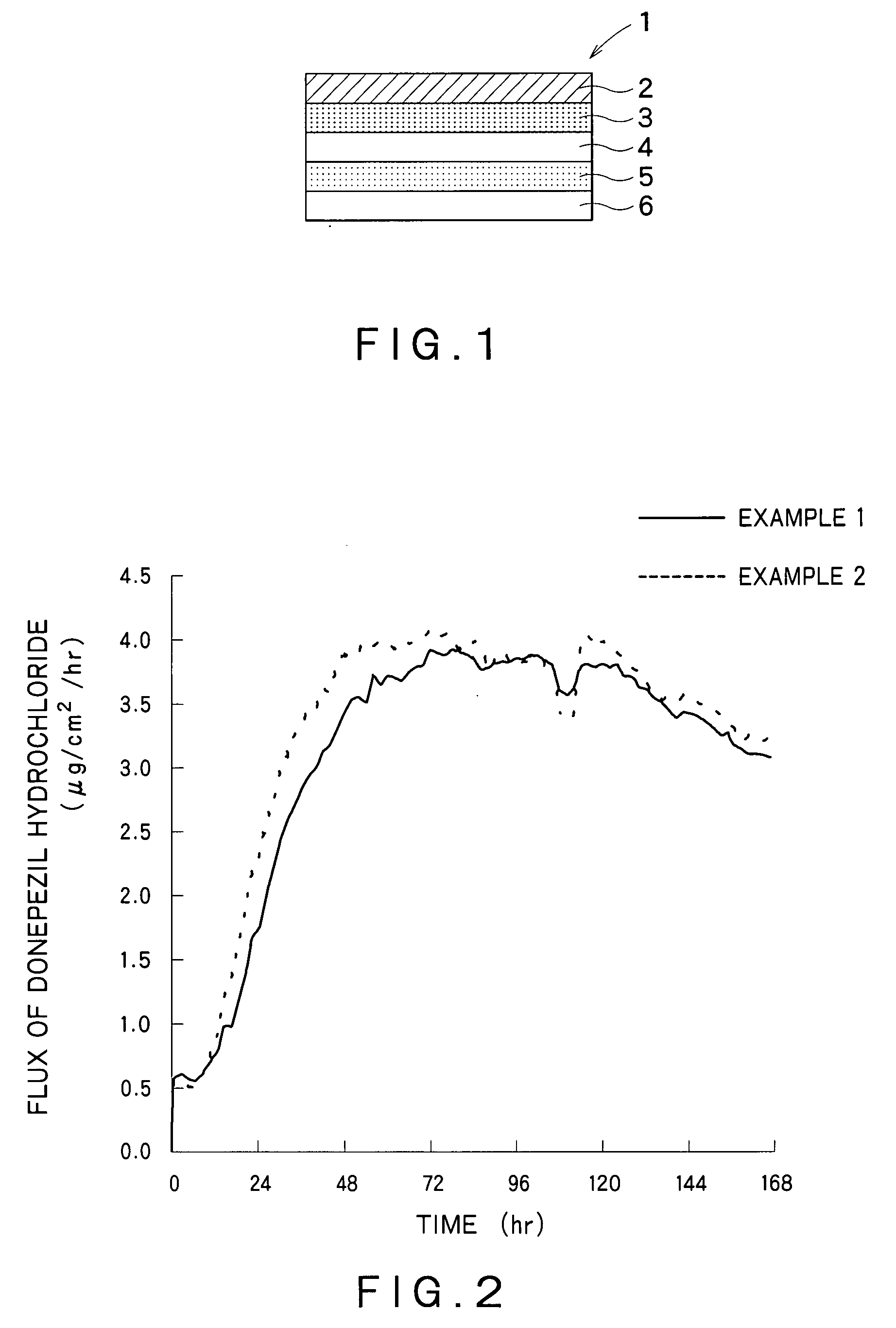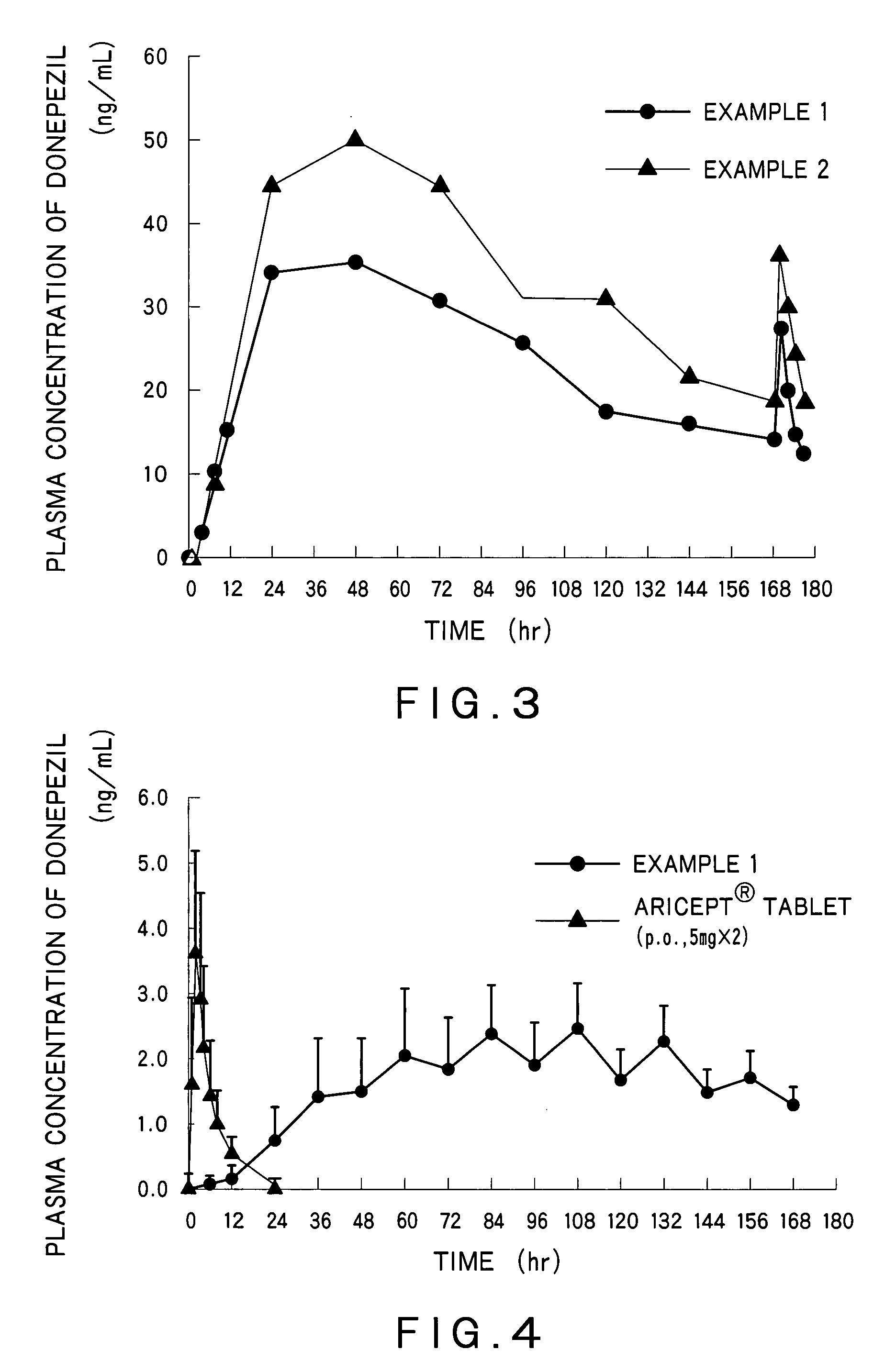Percutaneous absorption preparations of antidementia drugs
a technology of antidementia drugs and preparations, which is applied in the direction of drug compositions, biocide, bandages, etc., can solve the problems of increasing the number of dementia patients with alzheimer's type, difficult for dementia patients in an advanced stage to take an antidementia drug, and increasing the care of patients, so as to achieve stably release the antidementia drug and stabilize the preparation on the skin
- Summary
- Abstract
- Description
- Claims
- Application Information
AI Technical Summary
Benefits of technology
Problems solved by technology
Method used
Image
Examples
example 1
[0114]Preparation of a Drug Reservoir Layer
[0115]Eudragit® E100 (35.3 g) was dissolved in 45.9 g of ethyl acetate. To this solution were added 50 g of donepezil hydrochloride, 20 g of triethyl citrate, 20 g of glycerin and 10 g of sorbitan monolaurate, and the mixture was stirred. Next, 152.1 g of an acrylic polymer (Duro-Tak® 387-2516, National Starch & Chemical Co., Ltd.)(solid content: 42.5%) was added to the solution to give an adhesive mass solution. The adhesive mass solution was coated on a polyethylene terephthalate liner so that the coat after drying had a thickness of 100 μm. Then, the adhesive mass solution on the liner was dried at 70° C. for 15 minutes to form a drug reservoir layer having the desired thickness. Furthermore, the drug reservoir layer was laminated on a backing layer (Scotchpak®9732, 3M).
[0116]Preparation of an Adherent Layer and a Percutaneous Absorption Preparation
[0117]Triethyl citrate (12 g), sorbitan monolaurate (6 g), and an acrylic polymer (Duro-Ta...
example 2
[0119]A percutaneous absorption preparation was obtained by the similar manner to Example 1 with use of diethyl sebacate instead of triethyl citrate.
example 3
[0120]Preparation of a Drug Reservoir Layer
[0121]A drug reservoir layer was formed by the similar manner to Example 1 except that a laminated material of woven fabric and PET was used as a backing layer and the drug reservoir layer was laminated on the PET side of the backing layer.
[0122]Preparation of an Adherent Layer and a Percutaneous Absorption Preparation
[0123]Triethyl citrate (12 g), sorbitan monolaurate (6 g), an acrylic polymer (Duro-Tak®87-2287, National Starch & Chemical)(201.98 g; solid content: 50.5%), and ethyl acetate (46.69 g) were mixed by stirring. The adhesive mass solution obtained was coated on a polyethylene terephthalate liner so that the coat after drying had a thickness of 50 μm. Then, the adhesive mass solution on the liner was dried at 70° C. for 10 minutes to form an adherent layer having the desired thickness. A micro porous polypropylene membrane (Celgard®2400, Celgard Inc.) was laminated on the adherent layer.
[0124]The liner of the drug reservoir layer...
PUM
| Property | Measurement | Unit |
|---|---|---|
| Time | aaaaa | aaaaa |
| Percent by mass | aaaaa | aaaaa |
| Fraction | aaaaa | aaaaa |
Abstract
Description
Claims
Application Information
 Login to View More
Login to View More - R&D
- Intellectual Property
- Life Sciences
- Materials
- Tech Scout
- Unparalleled Data Quality
- Higher Quality Content
- 60% Fewer Hallucinations
Browse by: Latest US Patents, China's latest patents, Technical Efficacy Thesaurus, Application Domain, Technology Topic, Popular Technical Reports.
© 2025 PatSnap. All rights reserved.Legal|Privacy policy|Modern Slavery Act Transparency Statement|Sitemap|About US| Contact US: help@patsnap.com


